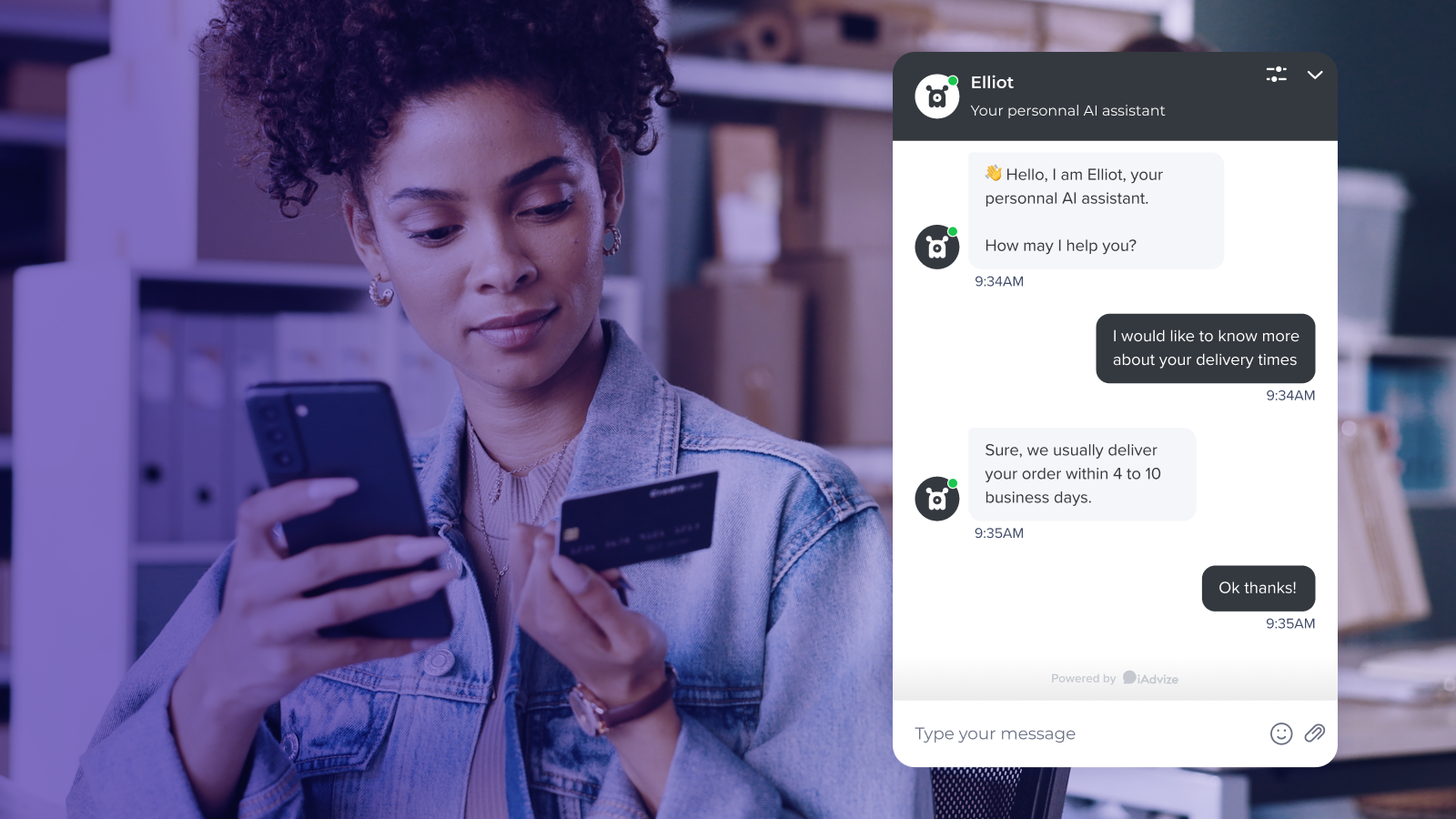What is Live Chat and How Can it Benefit Online Businesses?
iAdvize

What is live chat? Most people are familiar with the basics of chatbots and similar software packages. Perhaps the better question could be how and why real-time interactions are critical for e-commerce success in 2024. We'll examine this question, and take an in-depth look at some of the features of live chat that businesses might still not be aware of, in this article.
Defining Live Chat and Why It's Essential for E-Commerce Customer Support in 2024
Most of us associate chatbots with relatively modern software. However, this technology can actually trace its roots as far back as 1973 when a product known as Talkomatic was first launched. While capable of supporting real-time text messages between users, this system was hardly relevant for businesses at the time.
We would have to wait until the birth of the Word Wide Web before such interactions became commonplace. Live chat is now a part of our everyday existence, especially in the e-commerce industry.
Understanding Live Chat
What is Live Chat?
For our purposes, live chat can be defined as a way for businesses to engage with website visitors via instant messaging in real time. Essentially, live chat is modern chatbots that are supported by human representatives and AI-assisted software. The goals of this channel are to drive conversions, build brand loyalty, and streamline the shopping experience.
Implementing these platforms is only a single avenue in the larger client support landscape. As e-commerce becomes even more digitized, consumers now expect immediate, nearly perfect levels of customer support. Automation is important to providing this at scale, and live chat platforms could be the solution that many businesses have been looking for.
Key Features
Live chatbots must be outfitted with the latest tools and utilities. One example here includes omnichannel support including:
- Browsers such as Chrome and Firefox
- Smartphones
- In-app interfaces
Another one of the key benefits that contemporary platforms offer involves seamless transfer between AI-driven algorithms and humans. For instance, a shopper can always be directed to a human representative if the AI is unable to process a specific request or if more information is required.
Still, live chat involves far more than the customer-facing side of e-commerce. These systems boast a handful of other impressive functions. Examples include positive feedback rates, analytics and reporting, monthly turnover rates, trending keywords, and user-friendly dashboards. The goal here is twofold: to keep shoppers satisfied, and to provide agents with the clarity required to enhance their buying journey.
How Live Chat Works
Although many businesses rely on live chatbots to ensure customer satisfaction, and to increase sales, what occurs behind the scenes is a lesser-known concept that is important to mention. Understanding the basics is crucial if stakeholders want to make the most out of the latest tech trends. This is particularly the case for companies like Samsung that regularly deal with massive volume from their customer base, and require the latest solutions.
Mechanics of Live Chat Systems
From an enterprise-level perspective, communications often have to be monitored at scale. Older chatbots aren't often able to handle a large volume of inbound interactions, and customer satisfaction might suffer as a result.
This is also when the power of AI-assisted automation comes into play. For the sake of simplicity, a great way to view the mechanics of live chat systems involves the cycle outlined below:
- A customer begins a chat and is provided with a personalized greeting
- They interact with the AI chatbot
- If additional help is needed, the customer is transferred to a human agent
Note that chat responses typically depend on variables such as the stage of the customer journey or the page that the individual is viewing. Therefore, flexibility is another attribute of advanced automated chat software.
Integration With Other Customer Support Tools
Another key trait of an efficient chat service involves how it can be seamlessly integrated with other third-party e-commerce stacks such as Shopify, Zendesk, Salesforce, and Google Analytics. By consolidating these systems, businesses can further enhance the end-user experience while increasing the efficiency of their in-house customer service operations.
The Importance of Live Chat for E-Commerce in 2024
2024 could very well represent the red-letter year of automated chatbots. Let's take a closer look at what we mean.
Enhancing Customer Experience
Consumers are always looking for a balance between efficiency and personalization in their shopping experience. They're no longer tolerant of canned responses or generic replies to questions that could very well determine if a sale is made or lost.
For example, a recent study has shown that 85% of online shoppers are satisfied with a chat service that provides customized responses based on their queries. Business owners are learning to appreciate these observations, and AI-powered messaging platforms have begun to take on a life of their own.
For example, IKKS is an online fashion retailer that was previously struggling to meet the needs of their online shoppers with an outdated chat platform that was unable to adapt to the number of inbound queries.
After implementing a more modern AI-powered bot, they were able to enjoy an automated response rate of 80%. Conversions also increased, resulting in an appreciable return on investment (ROI).
Increasing Efficiency and Reducing Response Times
Another positive impact of leveraging this technology in e-commerce is how chatbots can decrease the amount of time required to provide a response, reaching near immediacy.
This also allows businesses to handle multiple inquiries that might have previously resulted in a communications bottleneck. In fact, because of this efficiency, well over 64% of businesses deploy AI-assisted bots to boost productivity.
Boosting Conversion Rates and Customer Retention
Conversion rates represent the bottom line of any business model, but are often jeopardized if customers don't remain loyal. Modern chat tools can offer the best of both worlds. Fast response times and personalization at scale will both offer a frictionless shopping experience and reduce cart abandonment rates.
Real-Time Support and Accessibility
Let's also remember that unlike older communication services, chatbots are available on a 24/7 basis. This guarantees that customers will always receive real-time support. Even if a human isn't available, like after business hours, the AI-powered bot can either resolve the issue itself, or create a ticket to signal an agent to contact the customer when they're back online.
Data Collection and Insights
Which products are the most popular at any given moment? Have customers responded positively to a particular marketing campaign? Are there certain complaints that seem to crop up more than others?
Chatbot software can provide the answers to these, and many other questions, aggregating the information from all channels and making it possible for agents to uncover patterns and better understand the result of their efforts. This information also helps them make changes to key informational resources, like product catalogs and FAQs, as required.
Best Practices for Implementing Live Chat
Businesses can hardly deny the positive impacts that AI-enhanced chat platforms will have on their operations. Still, not all platforms are created equally. Here are some things to think about during the decision making process:
- Determine the needs of the business
- Identify what challenges are present and define the ideal customer experience
- Decide which features are the most important (such as tone of voice, the type of product information offered, and supported languages)
- Connect the chatbot to existing sources of data
- Make certain that the service is compliant with all relevant data laws and regulations
- Define and proactively track important KPIs
Finally, businesses must always make an effort to choose the latest generation of AI chatbots. These will offer the cutting-edge experience that consumers now expect, and further streamline the shopping journey.
Training and Managing Live Chat Agents
It's important to remember that human agents are, and should always be, a critical part of the shopping journey. Automated chatbots exist to expedite the information-gathering and decision-making processes, then pass to human representatives when they've hit their proverbial ceiling.
Brands and retailers must prioritize providing the proper onboarding and training so that representatives can make the most out of this advanced technology. For best results, training should be viewed as an ongoing process as the needs of the business (and the functions of the software) continue to evolve.
Optimizing Live Chat for Maximum Impact
Even with all of the advantages that have been highlighted above, there are still additional strategies that can be used to further enhance customer support. For example, a messaging icon should be placed in the same location on every page of a website. This will allow customers to easily access real-time support if they have a question or concern.
The chatbot should also offer an intuitive design so that those who might not possess a great deal of technical experience can still get the help they need. The same holds true when discussing a mobile-responsive design. All chat software should be compatible with smartphone operating systems such as iOS and Android.
Finally, the platform must be scalable. There may be times when new features need to be added, or even instances when a more simplified version is the best solution. Without this level of flexibility, the software might not be able to evolve with the needs of the business model. Flexible platforms will provide companies with an undeniable edge in the e-commerce space, and more importantly, guarantee that shoppers are satisfied with their overall experience.

.png)
.png)







